Monitoring the Landscape Pattern Dynamics and Driving Forces in Dongting Lake Wetland in China Based on Landsat Images
Abstract
1. Introduction
2. Materials and Methods
2.1. Study Area
2.2. Datasets and Pre-Processing
2.2.1. Remote Sensing Data
2.2.2. Field Measurement Data
2.2.3. Hydrology and Meteorological Data
2.3. Methodology
2.3.1. CART Decision Tree Classification Method
2.3.2. Landscape Pattern Index
- 1.
- PD
- 2.
- ED
- 3.
- SHDI
- 4.
- SHEI
- 5.
- LSI
- 6.
- FRAC_MN
2.3.3. Dynamic Degree and Transition Matrix Models
- 7.
- Dynamic degree model
- 8.
- Transition matrix model
3. Results
3.1. Accuracy Verification Results of SVM, ML, and CART Methods
3.2. Spatio-Temporal Changes in Wetland Landscape
3.3. Driving Factors of Wetland Landscape
4. Discussion
4.1. Influencing Forces of Dongting Lake Wetland Dynamics
4.2. Dynamic Evolution of Dongting Lake Wetland
4.3. Limitations and Future Work
5. Conclusions
Supplementary Materials
Author Contributions
Funding
Data Availability Statement
Acknowledgments
Conflicts of Interest
References
- Hu, S.; Niu, Z.; Chen, Y.; Li, L.; Zhang, H. Global wetlands: Potential distribution, wetland loss, and status. Sci. Total Environ. 2017, 586, 319–327. [Google Scholar] [CrossRef] [PubMed]
- Kaplan, G.; Avdan, U. Mapping and monitoring wetlands using Sentinel-2 satellite imagery. ISPRS Ann. Photogramm. Remote Sens. Spat. Inf. Sci. 2017, 4, 271–277. [Google Scholar] [CrossRef]
- Wei, X.; Wang, S.; Wang, Y. Spatial and temporal change of fractional vegetation cover in North-western China from 2000 to 2010. Geol. J. 2018, 53, 427–434. [Google Scholar] [CrossRef]
- Shen, G.; Yang, X.; Jin, Y.; Xu, B.; Zhou, Q. Remote sensing and evaluation of the wetland ecological degradation process of the Zoige Plateau Wetland in China. Ecol. Indic. 2019, 104, 48–58. [Google Scholar] [CrossRef]
- Granata, F.; Gargano, R.; de Marinis, G. Artificial intelligence based approaches to evaluate actual evapotranspiration in wetlands. Sci. Total Environ. 2020, 703, 135653. [Google Scholar] [CrossRef] [PubMed]
- Mao, D.; Wang, Z.; Wu, J.; Wu, B.; Zeng, Y.; Song, K.; Yi, K.; Luo, L. China’s wetlands loss to urban expansion. Land Degrad. Dev. 2018, 29, 2644–2657. [Google Scholar] [CrossRef]
- Bian, H.; Li, W.; Li, Y.; Ren, B.; Niu, Y.; Zeng, Z. Driving forces of changes in China’s wetland area from the first (1999–2001) to second (2009–2011) National Inventory of Wetland Resources. Glob. Ecol. Conserv. 2020, 21, e00867. [Google Scholar] [CrossRef]
- Niu, Z.; Zhang, H.; Wang, X.; Yao, W.; Zhou, D.; Zhao, K.; Zhao, H.; Li, N.; Huang, H.; Li, C. Mapping wetland changes in China between 1978 and 2008. Chin. Sci. Bull. 2012, 57, 2813–2823. [Google Scholar] [CrossRef]
- Bansal, S.; Creed, I.F.; Tangen, B.A.; Bridgham, S.D.; Desai, A.R.; Krauss, K.W.; Neubauer, S.C.; Noe, G.B.; Rosenberry, D.O.; Trettin, C.; et al. Practical Guide to Measuring Wetland Carbon Pools and Fluxes. Wetlands 2023, 43, 105. [Google Scholar] [PubMed]
- Zhao, C.; Gong, J.; Zeng, Q.; Yang, M.; Wang, Y. Landscape pattern evolution processes and the driving forces in the wetlands of lake Baiyangdian. Sustainability 2021, 13, 9747. [Google Scholar] [CrossRef]
- Liu, Y.; Yang, P.; Zhang, S.; Wang, W. Dynamic identification and health assessment of wetlands in the middle reaches of the Yangtze River basin under changing environment. J. Clean. Prod. 2022, 345, 131105. [Google Scholar] [CrossRef]
- Yang, R.; Chen, Y.; Qiu, Y.; Lu, K.; Wang, X.; Sun, G.; Liang, Q.; Song, H.; Liu, S. Assessing the Landscape Ecological Health (LEH) of Wetlands: Research Content and Evaluation Methods (2000–2022). Water 2023, 15, 2410. [Google Scholar] [CrossRef]
- Melnychenko, T.; Solovey, T. Mapping Water Bodies and Wetlands from Multispectral and SAR Data for the Cross-Border River Basins of the Polish–Ukrainian Border. Water 2024, 16, 407. [Google Scholar] [CrossRef]
- Shi, K.; Zhang, Y.; Zhu, G.; Liu, X.; Zhou, Y.; Xu, H.; Qin, B.; Liu, G.; Li, Y. Long-term remote monitoring of total suspended matter concentration in Lake Taihu using 250 m MODIS-Aqua data. Remote Sens. Environ. 2015, 164, 43–56. [Google Scholar] [CrossRef]
- Ahmadzadeh, R.; Dehdar, D.M.; Khorasani, N.; Farsad, F.; Rahimibashar, M.R. Assessment of wetland landscape changes based on landscape metrics and trophic state index (case study: Anzali International Wetland). Environ. Monit. Assess. 2023, 195, 1206. [Google Scholar] [CrossRef] [PubMed]
- Fan, C.; Yang, J.; Zhao, G.; Dai, J.; Zhu, M.; Dong, J.; Liu, R.; Zhang, G. Mapping Phenology of Complicated Wetland Landscapes through Harmonizing Landsat and Sentinel-2 Imagery. Remote Sens. 2023, 15, 2413. [Google Scholar] [CrossRef]
- Zhang, M.; Lin, H. Wetland classification using parcel-level ensemble algorithm based on Gaofen-6 multispectral imagery and Sentinel-1 dataset. J. Hydrol. 2022, 606, 127462. [Google Scholar] [CrossRef]
- Cheng, S.; Yang, X.; Yang, G.; Chen, B.; Chen, B.; Wang, J.; Ren, K.; Sun, W. Using ZY1-02D satellite hyperspectral remote sensing to monitor landscape diversity and its spatial scaling change in the Yellow River Estuary. Int. J. Appl. Earth Obs. Geoinf. 2024, 128, 103716. [Google Scholar] [CrossRef]
- Wang, J.; Sheng, Y.; Tong, T.S.D. Monitoring decadal lake dynamics across the Yangtze Basin downstream of Three Gorges Dam. Remote Sens. Environ. 2014, 152, 251–269. [Google Scholar] [CrossRef]
- Lamsal, P.; Atreya, K.; Ghosh, M.K.; Pant, K.P. Effects of population, land cover change, and climatic variability on wetland resource degradation in a Ramsar listed Ghodaghodi Lake Complex, Nepal. Environ. Monit. Assess. 2019, 191, 415. [Google Scholar] [CrossRef]
- Yu, S.; Li, C.a.; Yu, D.; He, Q.; Luo, W.; Xiang, F. Land Cover Change on Beach of Dongting Lake’s Beach. J. Earth Sci. 2020, 45, 1918–1927. [Google Scholar]
- Peng, Y.; He, G.; Wang, G.; Cao, H. Surface Water Changes in Dongting Lake from 1975 to 2019 Based on Multisource Remote-Sensing Images. Remote Sens. 2021, 13, 1827. [Google Scholar] [CrossRef]
- Ye, W. Remote sensing image land type data mining based on QUEST decision tree. Clust. Comput. 2019, 22, 8437–8443. [Google Scholar]
- Hu, J.; Xie, Y.; Tang, Y.; Li, F.; Zou, Y. Changes of Vegetation Distribution in the East Dongting Lake After the Operation of the Three Gorges Dam, China. Front. Plant Sci. 2018, 9, 582. [Google Scholar] [CrossRef]
- Hu, Y.; Huang, J.; Du, Y.; Han, P.; Wang, J.; Huang, W. Monitoring wetland vegetation pattern response to water-level change resulting from the Three Gorges Project in the two largest freshwater lakes of China. Ecol. Eng. 2015, 74, 274–285. [Google Scholar] [CrossRef]
- Lai, X.; Jiang, J.; Huang, Q. Effects of the normal operation of the Three Gorges Reservoir on wetland inundation in Dongting Lake, China: A modelling study. Hydrol. Sci. J. 2013, 58, 1467–1477. [Google Scholar] [CrossRef]
- Yang, L.; Wang, L.; Yu, D.; Yao, R.; He, Q.; Wang, S.; Wang, L. Four decades of wetland changes in Dongting Lake using Landsat observations during 1978–2018. J. Hydrol. 2020, 587, 124954. [Google Scholar] [CrossRef]
- Zhou, J.; Wan, R.; Wu, X.; Zhang, Y. Patterns of long-term distribution of typical wetland vegetation (1987–2016) and its response to hydrological processes in Lake Dongting. J. Lake Sci. 2020, 32, 1723–1735. [Google Scholar]
- Chen, J.; Zhu, X.; Vogelmann, J.E.; Gao, F.; Jin, S. A simple and effective method for filling gaps in Landsat ETM + SLC-off images. Remote Sens. Environ. 2011, 115, 1053–1064. [Google Scholar] [CrossRef]
- Penman, H.L. Natural evaporation from open water, bare soil and grass. Proc. R. Soc. Lond. Ser. A-Math. Phys. Eng. Sci. 1948, 193, 120–145. [Google Scholar]
- Chi, D.; Wang, H.; Li, X.; Liu, H.; Li, X. Estimation of the ecological water requirement for natural vegetation in the Ergune River basin in Northeastern China from 2001 to 2014. Ecol. Indic. 2018, 92, 141–150. [Google Scholar] [CrossRef]
- Masurkar, A.; Daruwala, R.; Mohite, A. Performance analysis of SAR filtering techniques using SVM and Wishart Classifier. Remote Sens. Appl.-Soc. Environ. 2024, 34, 101189. [Google Scholar] [CrossRef]
- Rimal, B.; Rijal, S.; Kunwar, R. Comparing Support Vector Machines and Maximum Likelihood Classifiers for Mapping of Urbanization. J. Indian Soc. Remote Sens. 2020, 48, 71–79. [Google Scholar] [CrossRef]
- Lin, W.; Cen, J.; Xu, D.; Du, S.; Gao, J. Wetland landscape pattern changes over a period of rapid development (1985–2015) in the ZhouShan Islands of Zhejiang province, China. Estuar. Coast. Shelf Sci. 2018, 213, 148–159. [Google Scholar] [CrossRef]
- Yao, B.; Zhang, H.; Liu, Y.; Liu, H.; Ling, C. Remote Sensing Classification of Wetlands based on Object-oriented and CART Decision Tree Method. For. Res. 2019, 32, 91–98. [Google Scholar]
- Tardanico, J.; Hovestadt, T. Effects of compositional heterogeneity and spatial autocorrelation on richness and diversity in simulated landscapes. Ecol. Evol. 2023, 13, e10810. [Google Scholar] [CrossRef] [PubMed]
- Xie, C.; Huang, X.; Mu, H.; Yin, W. Impacts of Land-Use Changes on the Lakes across the Yangtze Floodplain in China. Environ. Sci. Technol. 2017, 51, 3669–3677. [Google Scholar] [CrossRef]
- Liu, J.; Gao, J.; Dong, C. Regional differentiation and factors influencing changes in swamps in the Sanjiang Plain from 1954 to 2015. Acta Ecol. Sin. 2019, 39, 4821–4831. [Google Scholar]
- Wu, L.; Li, Z.; Liu, X.; Zhu, L.; Tang, Y.; Zhang, B.; Xu, B.; Liu, M.; Meng, Y.; Liu, B. Multi-Type Forest Change Detection Using BFAST and Monthly Landsat Time Series for Monitoring Spatiotemporal Dynamics of Forests in Subtropical Wetland. Remote Sens. 2020, 12, 341. [Google Scholar] [CrossRef]
- Wang, H.; Bai, X.; Huang, L.; Hong, F.; Yuan, W.; Guo, W. The spatial variation of hydrological conditions and their impact on wetland vegetation in connected floodplain wetlands: Dongting Lake Basin. Environ. Sci. Pollut. Res. Int. 2024, 31, 8483–8498. [Google Scholar] [CrossRef]
- Huang, Y.; Chen, X.; Li, F.; Hou, Z.; Li, X.; Zeng, J.; Deng, Z.; Zou, Y.; Xie, Y. Community Trait Responses of Three Dominant Macrophytes to Variations in Flooding During 2011–2019 in a Yangtze River-Connected Floodplain Wetland (Dongting Lake, China). Front. Plant Sci. 2021, 12, 604677. [Google Scholar] [CrossRef]
- Deng, F.; Wang, X.; Cai, X.; Li, E.; Jiang, L.; Li, H.; Yan, R. Analysis of the relationship between inundation frequency and wetland vegetation in Dongting Lake using remote sensing data. Ecohydrology 2014, 7, 717–726. [Google Scholar] [CrossRef]
- Xie, Y.; Tang, Y.; Chen, X.; Li, F.; Deng, Z. The impact of Three Gorges Dam on the downstream eco-hydrological environment and vegetation distribution of East Dongting Lake. Ecohydrology 2015, 8, 738–746. [Google Scholar] [CrossRef]
- Zhang, Y.; Wang, D.; Wu, X.; Lai, X. Driving factors of wetland evolution in Lake Dongting during 1900–2020. J. Lake Sci. 2023, 35, 1786–1795. [Google Scholar]
- Yang, Z.; Han, L.; Liu, Q.; Li, C.; Pan, Z.; Xu, K. Spatial and Temporal Changes in Wetland in Dongting Lake Basin of China under Long Time Series from 1990 to 2020. Sustainability 2022, 14, 3620. [Google Scholar] [CrossRef]
- Long, X.; Lin, H.; An, X.; Chen, S.; Qi, S.; Zhang, M. Evaluation and analysis of ecosystem service value based on land use/cover change in Dongting Lake wetland. Ecol. Indic. 2022, 136, 108619. [Google Scholar] [CrossRef]
- Zhang, M.; Lin, H.; Long, X.; Cai, Y. Analyzing the spatiotemporal pattern and driving factors of wetland vegetation changes using 2000-2019 time-series Landsat data. Sci. Total Environ. 2021, 780, 146615. [Google Scholar] [CrossRef]
- Tan, Z.; Zhang, Q.; Li, M.; Li, Y.; Xu, X.; Jiang, J. A study of the relationship between wetland vegetation communities and water regimes using a combined remote sensing and hydraulic modeling approach. Hydrol. Res. 2016, 47, 278–292. [Google Scholar]
- Guo, D.; Shi, W.; Qian, F.; Wang, S.; Cai, C. Monitoring the spatiotemporal change of Dongting Lake wetland by integrating Landsat and MODIS images, from 2001 to 2020. Ecol. Inf. 2022, 72, 101848. [Google Scholar] [CrossRef]
- Peng, H.; Xia, H.; Shi, Q.; Tang, Z.; Chen, H. Monitoring of wetland cover changes in protected areas to trade-offs between ecological conservation and food security: A case study from the Dongting Lake, China. Ecol. Inf. 2023, 78, 102338. [Google Scholar] [CrossRef]
- Luo, Q.; Li, Y.; Cao, X.; Jiang, S.; Yu, H. The Spatial and Temporal Variability of the Blue–Green Spatial Structures of the South Dongting Lake Wetland Areas Amidst Climate Change, including Its Relationship with Meteorological Factors. Water 2024, 16, 209. [Google Scholar] [CrossRef]
- Cai, Y.; Liu, S.; Lin, H. Monitoring the Vegetation Dynamics in the Dongting Lake Wetland from 2000 to 2019 Using the BEAST Algorithm Based on Dense Landsat Time Series. Appl. Sci. 2020, 10, 4209. [Google Scholar] [CrossRef]
- Song, R.; Lin, H.; Wang, G.; Yan, E.; Ye, Z. Improving Selection of Spectral Variables for Vegetation Classification of East Dongting Lake, China, Using a Gaofen-1 Image. Remote Sens. 2018, 10, 50. [Google Scholar] [CrossRef]
- Xing, L.; Tang, X.; Wang, H.; Fan, W.; Gao, X. Mapping Wetlands of Dongting Lake in China Using Landsat and sentinel-1 time series at 30M. Int. Arch. Photogramm. Remote Sens. Spat. Inf. Sci. 2018, 42, 1971–1976. [Google Scholar] [CrossRef]
- Cai, Y.; Lin, H.; Zhang, M. Mapping paddy rice by the object-based random forest method using time series Sentinel-1/Sentinel-2 data. Adv. Space Res. 2019, 64, 2233–2244. [Google Scholar] [CrossRef]
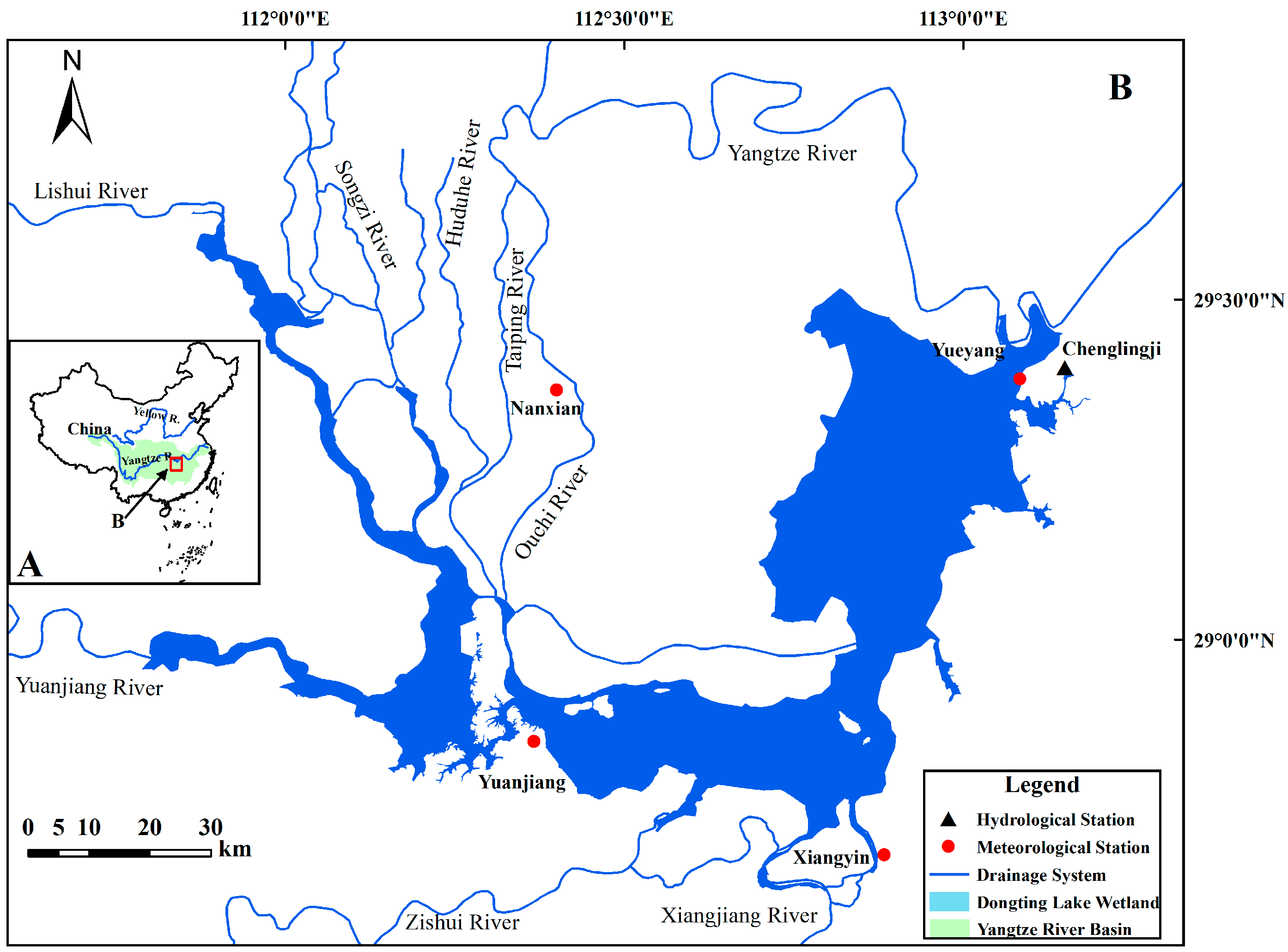
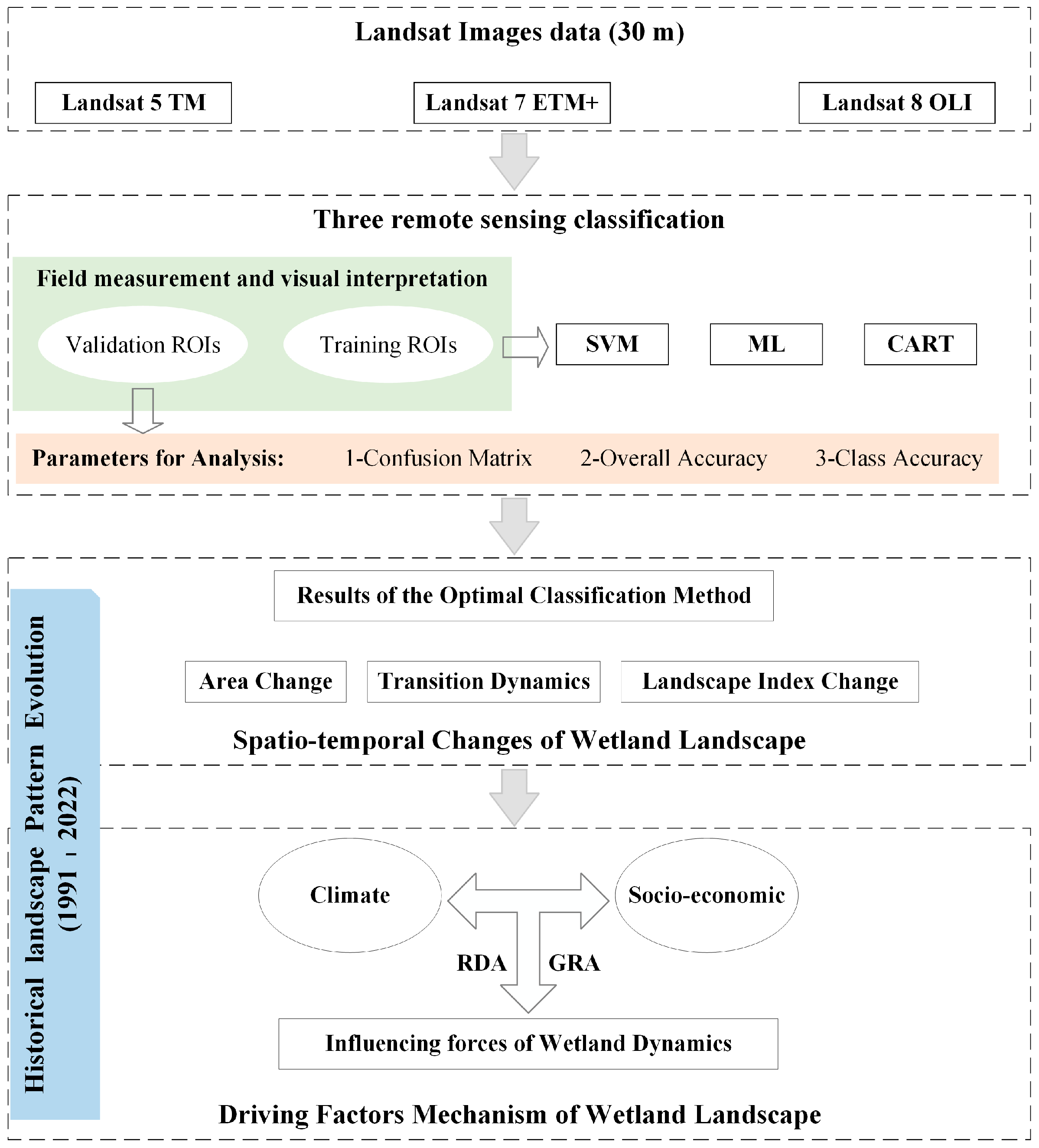
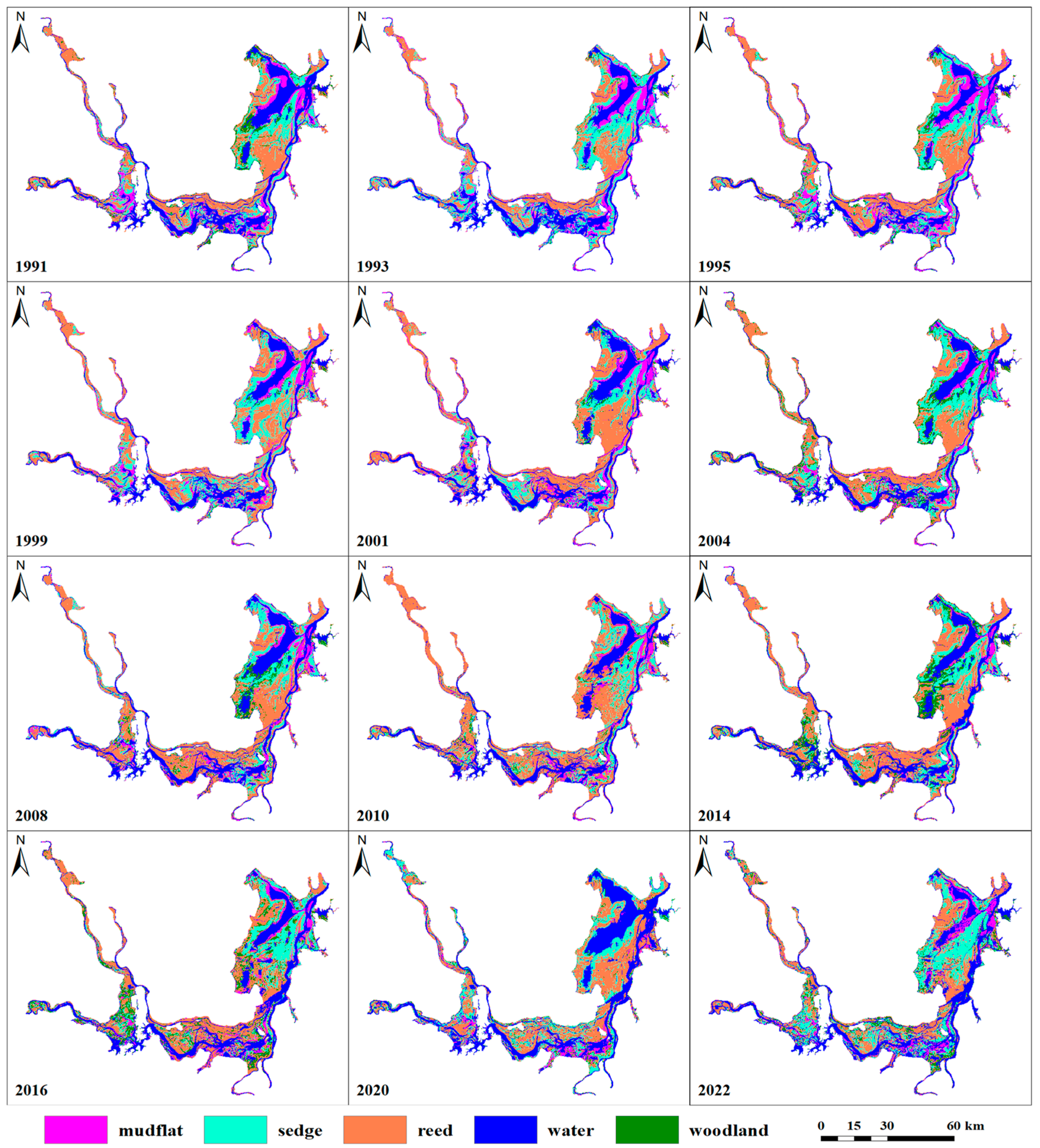
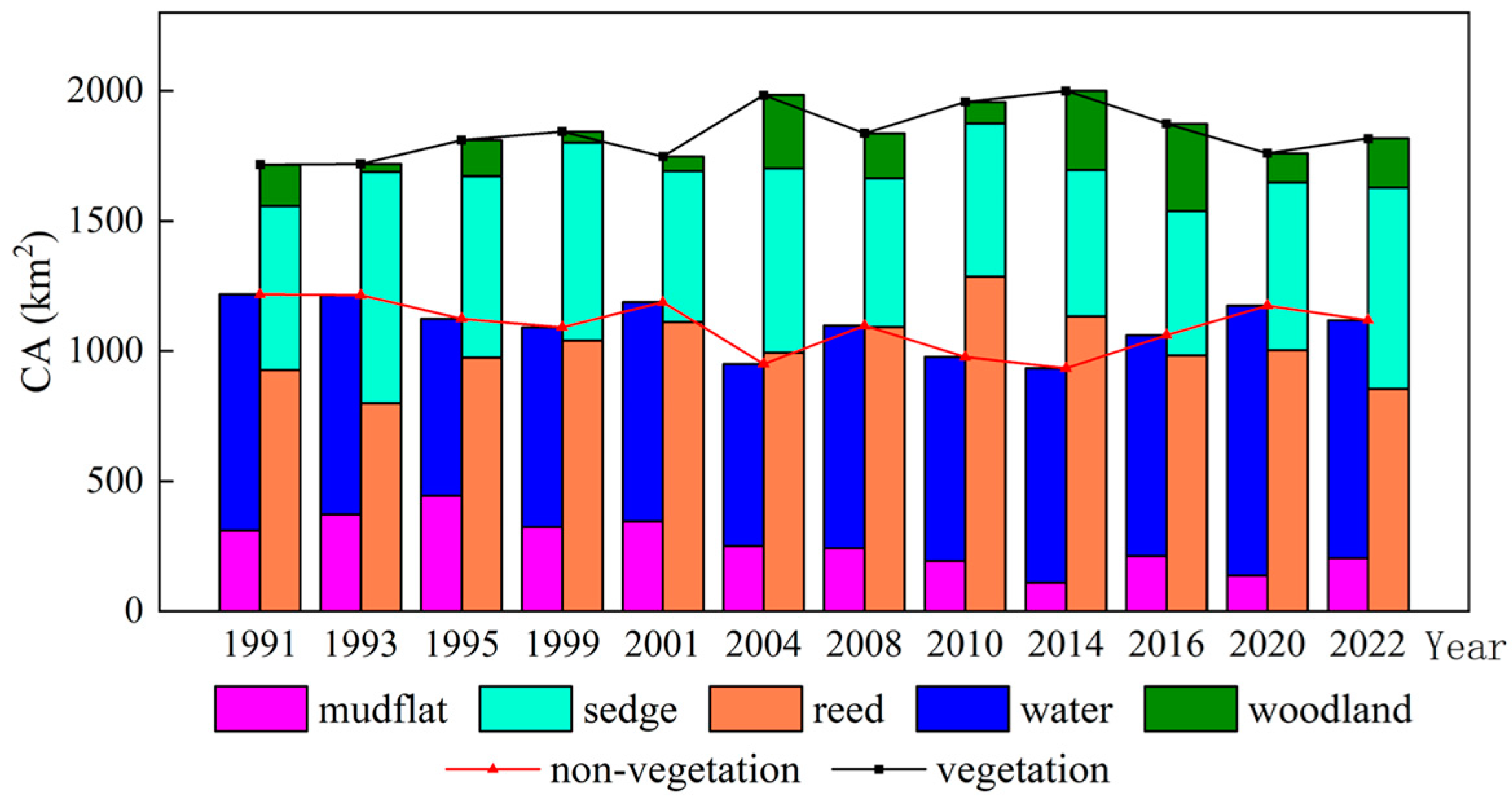
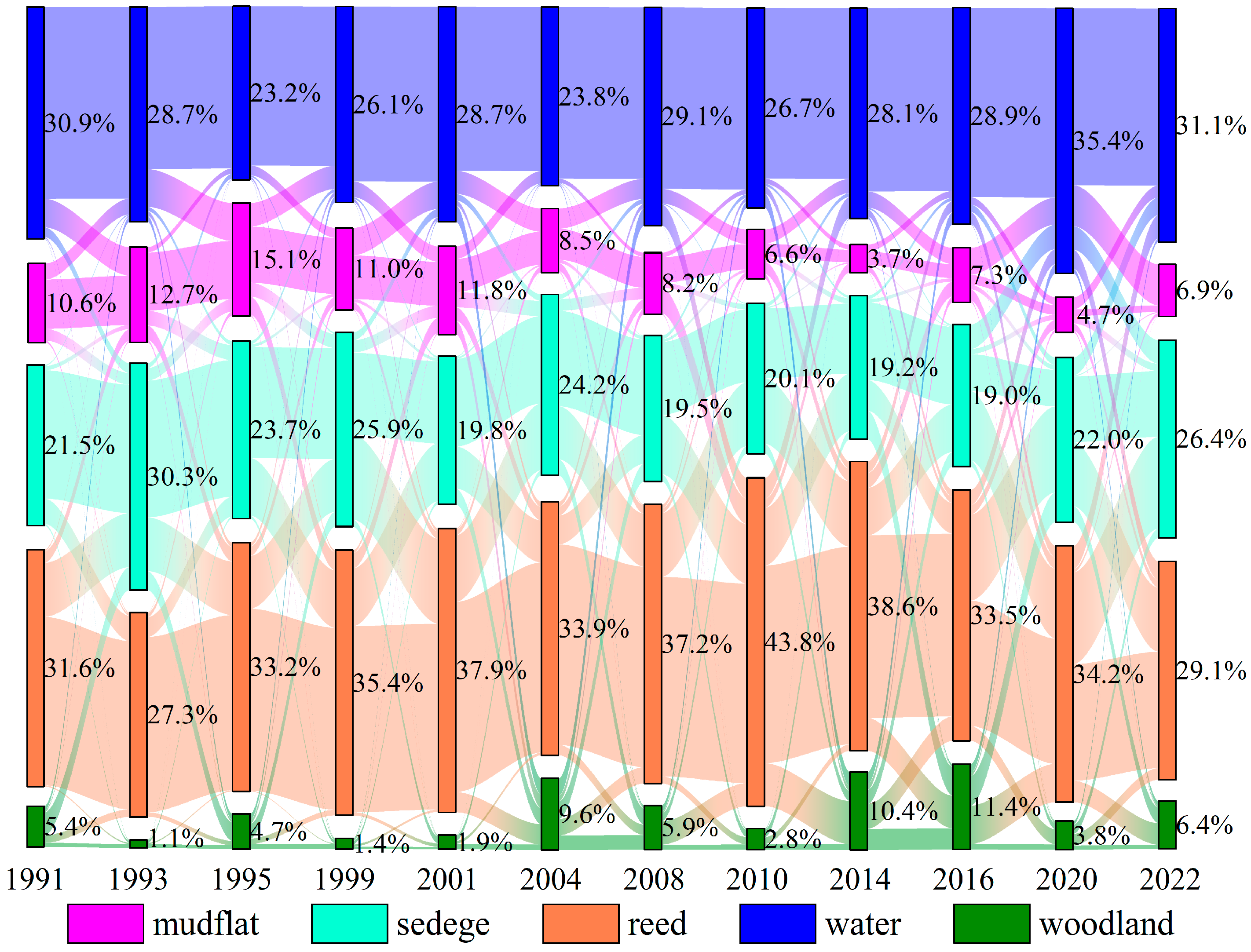


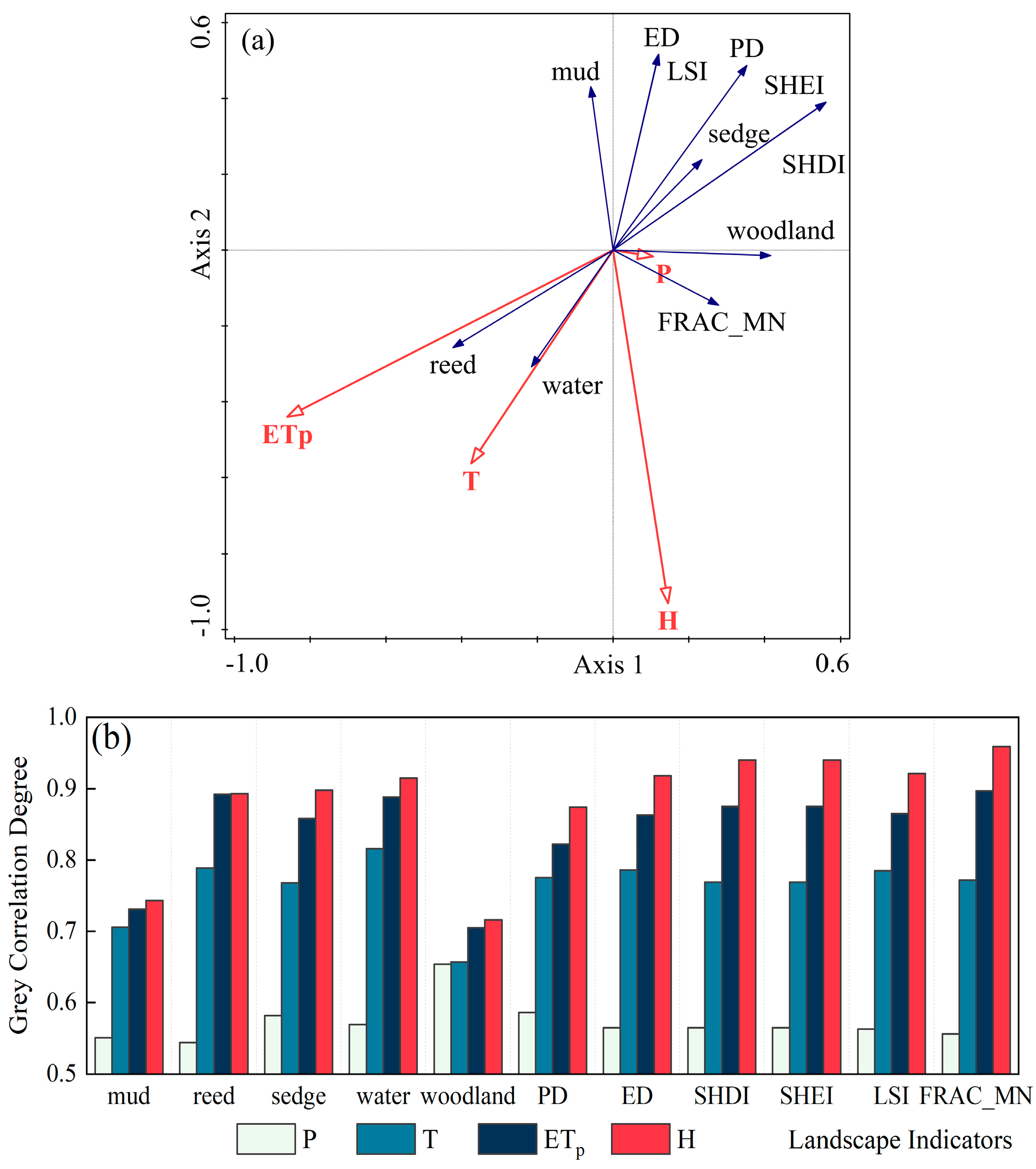

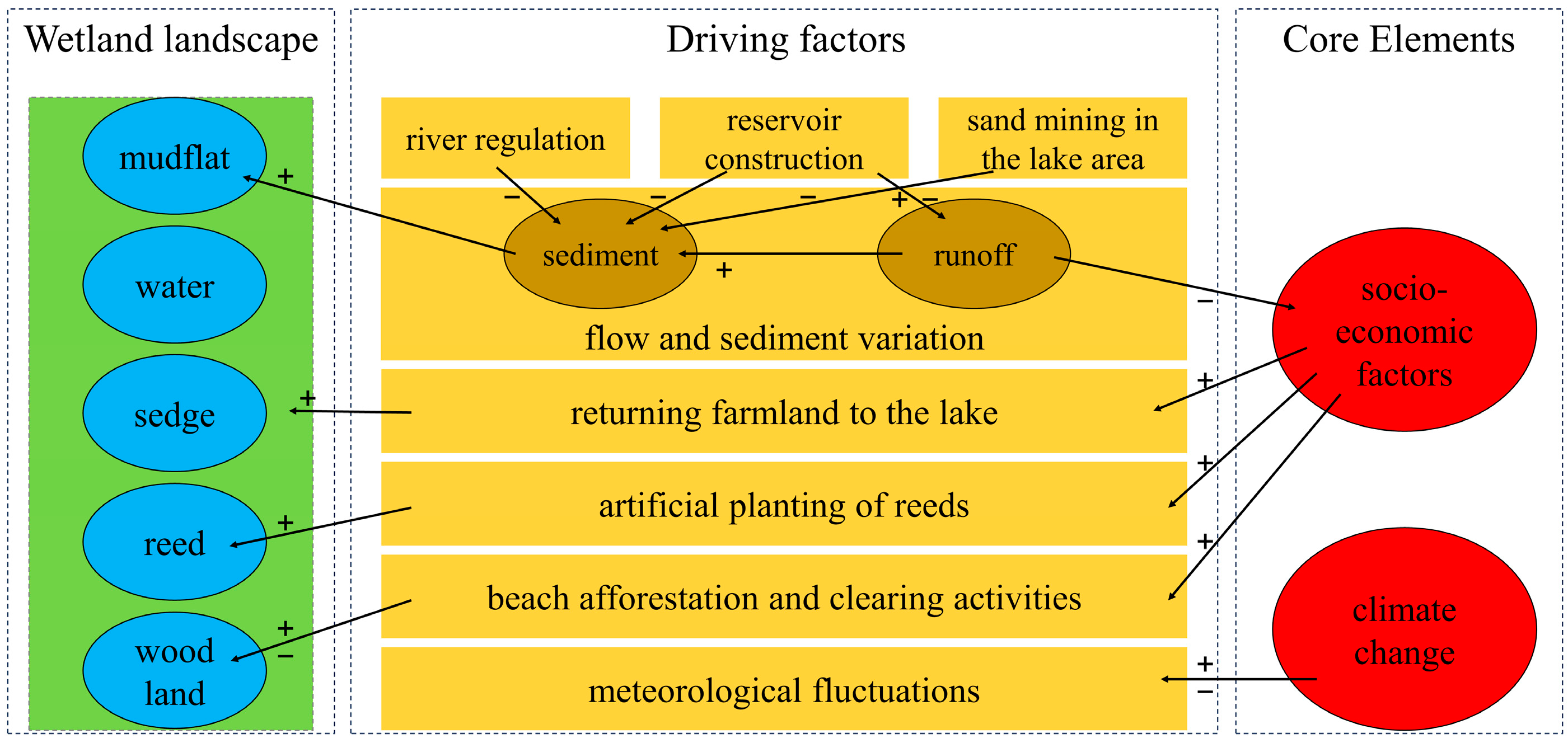
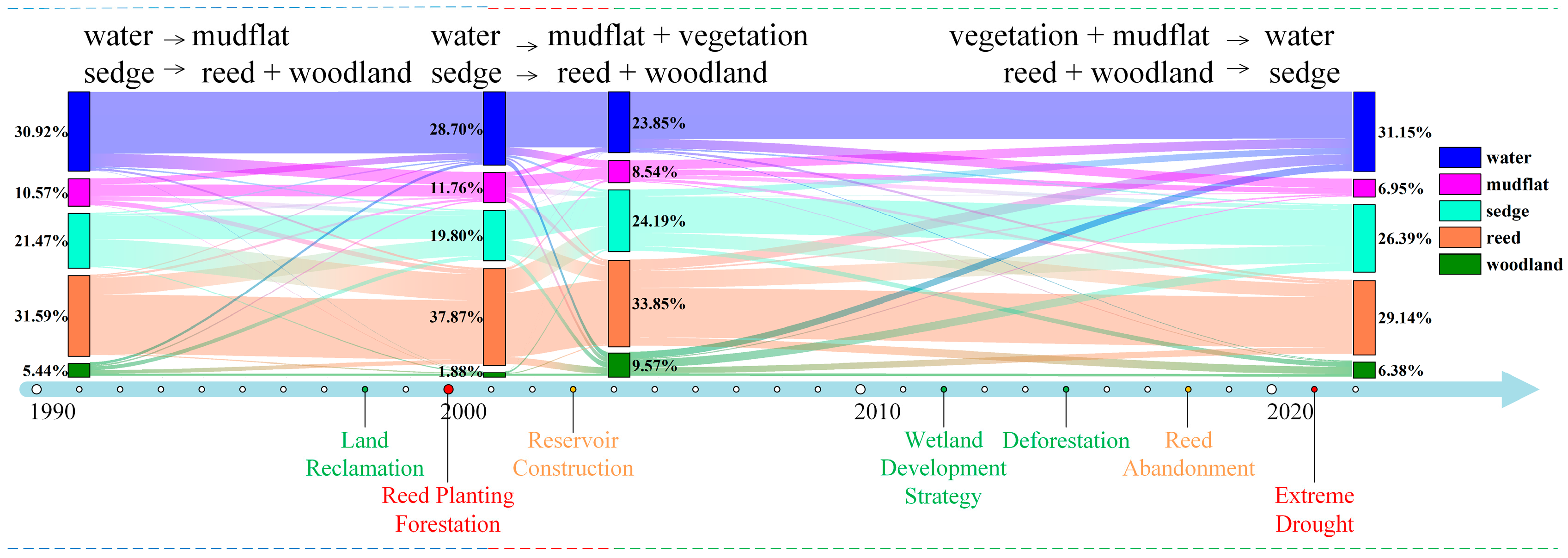
| Number | Year | Row/Path: 123/40 | Row/Path: 124/40 | Water Level (m) | ||
|---|---|---|---|---|---|---|
| Data | Satellite | Data | Satellite | |||
| 1 | 1991 | 11.8 | TM | 11.15 | TM | 22.96 |
| 2 | 1993 | 12.31 | TM | 12.6 | TM | 22.43 |
| 3 | 1995 | 12.5 | TM | 12.28 | TM | 20.77 |
| 4 | 1999 | 12.24 | ETM+ | 12.15 | ETM+ | 21.30 |
| 5 | 2001 | 12.29 | ETM+ | 10.1 | ETM+ | 20.56 |
| 6 | 2004 | 12.5 | ETM+ | 12.12 | ETM+ | 22.19 |
| 7 | 2008 | 12.8 | TM | 12.31 | TM | 21.64 |
| 8 | 2010 | 11.12 | TM | 11.19 | TM | 21.88 |
| 9 | 2014 | 12.17 | ETM+ | 12.8 | ETM+ | 22.65 |
| 10 | 2016 | 11.28 | OLI | 12.5 | OLI | 21.87 |
| 11 | 2020 | 11.7 | OLI | 11.14 | OLI | 23.80 |
| 12 | 2022 | 12.23 | OLI | 12.22 | OLI | 19.44 |
| Year | SVM | ML | CART | |||
|---|---|---|---|---|---|---|
| Accuracy | Kappa | Accuracy | Kappa | Accuracy | Kappa | |
| 1991 | 93.59% | 0.9171 | 92.43% | 0.9029 | 93.09% | 0.9111 |
| 1993 | 88.29% | 0.8470 | 92.47% | 0.9012 | 90.80% | 0.8794 |
| 1995 | 94.68% | 0.9320 | 94.18% | 0.9259 | 95.01% | 0.9362 |
| 1999 | 94.09% | 0.9248 | 94.96% | 0.9359 | 94.43% | 0.9290 |
| 2001 | 93.43% | 0.9165 | 97.61% | 0.9698 | 91.49% | 0.8919 |
| 2004 | 98.21% | 0.9769 | 98.37% | 0.979 | 96.42% | 0.9537 |
| 2008 | 92.64% | 0.9057 | 93.13% | 0.912 | 92.80% | 0.9082 |
| 2010 | 94.53% | 0.9289 | 92.87% | 0.9082 | 91.54% | 0.8901 |
| 2014 | 95.16% | 0.9361 | 95.76% | 0.9445 | 93.80% | 0.9183 |
| 2016 | 91.82% | 0.8957 | 89.20% | 0.8638 | 92.64% | 0.9062 |
| 2020 | 95.88% | 0.9475 | 90.72% | 0.8811 | 90.72% | 0.8822 |
| 2022 | 86.76% | 0.8285 | 76.91% | 0.7056 | 90.88% | 0.8822 |
| Mean | 93.26% | 0.9130 | 92.38% | 0.9024 | 92.80% | 0.9074 |
| Time Interval | Mudflat | Water | Reed | Sedge | Woodland | Total |
|---|---|---|---|---|---|---|
| 1991–2001 | 1.12% | −0.72% | 1.99% | −0.78% | −6.55% | 0.75% |
| 2001–2004 | −9.12% | −5.64% | −3.54% | 7.40% | 136.57% | 4.03% |
| 2004–2022 | −1.04% | 1.70% | −0.77% | 0.50% | −1.85% | 0.53% |
Disclaimer/Publisher’s Note: The statements, opinions and data contained in all publications are solely those of the individual author(s) and contributor(s) and not of MDPI and/or the editor(s). MDPI and/or the editor(s) disclaim responsibility for any injury to people or property resulting from any ideas, methods, instructions or products referred to in the content. |
© 2024 by the authors. Licensee MDPI, Basel, Switzerland. This article is an open access article distributed under the terms and conditions of the Creative Commons Attribution (CC BY) license (https://creativecommons.org/licenses/by/4.0/).
Share and Cite
Guo, M.; Zhou, N.; Cai, Y.; Zhao, W.; Lu, S.; Liu, K. Monitoring the Landscape Pattern Dynamics and Driving Forces in Dongting Lake Wetland in China Based on Landsat Images. Water 2024, 16, 1273. https://doi.org/10.3390/w16091273
Guo M, Zhou N, Cai Y, Zhao W, Lu S, Liu K. Monitoring the Landscape Pattern Dynamics and Driving Forces in Dongting Lake Wetland in China Based on Landsat Images. Water. 2024; 16(9):1273. https://doi.org/10.3390/w16091273
Chicago/Turabian StyleGuo, Mengshen, Nianqing Zhou, Yi Cai, Wengang Zhao, Shuaishuai Lu, and Kehao Liu. 2024. "Monitoring the Landscape Pattern Dynamics and Driving Forces in Dongting Lake Wetland in China Based on Landsat Images" Water 16, no. 9: 1273. https://doi.org/10.3390/w16091273
APA StyleGuo, M., Zhou, N., Cai, Y., Zhao, W., Lu, S., & Liu, K. (2024). Monitoring the Landscape Pattern Dynamics and Driving Forces in Dongting Lake Wetland in China Based on Landsat Images. Water, 16(9), 1273. https://doi.org/10.3390/w16091273






